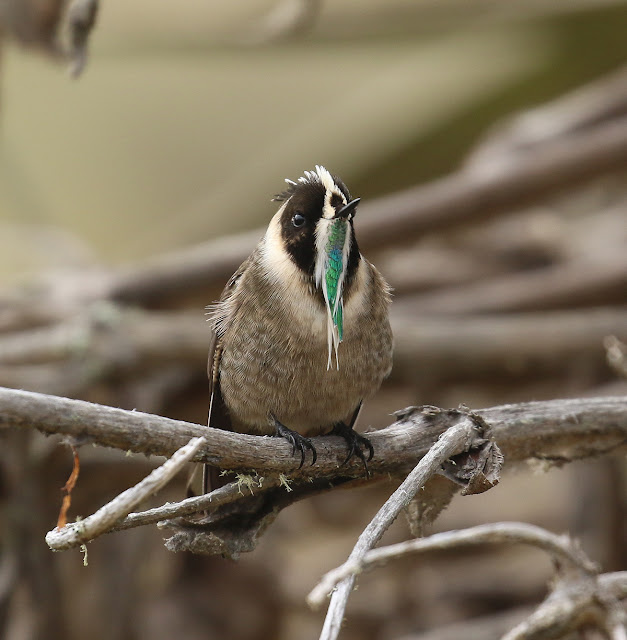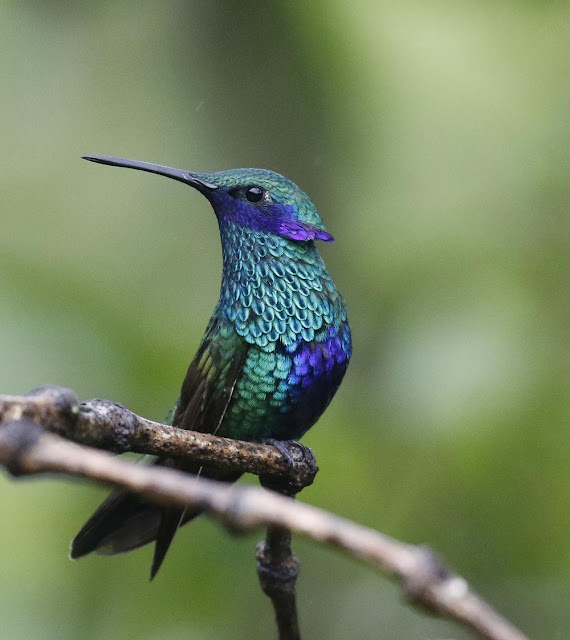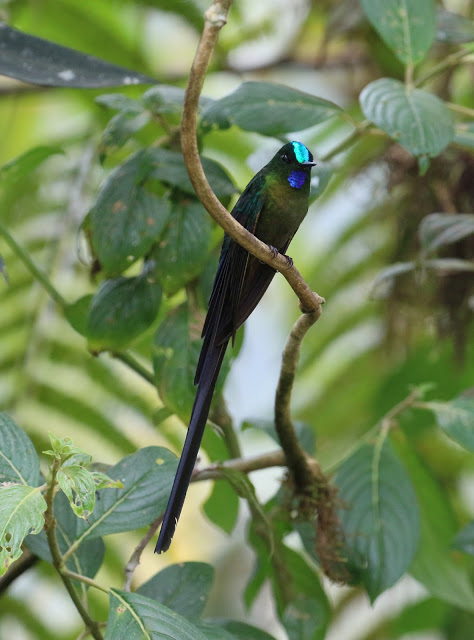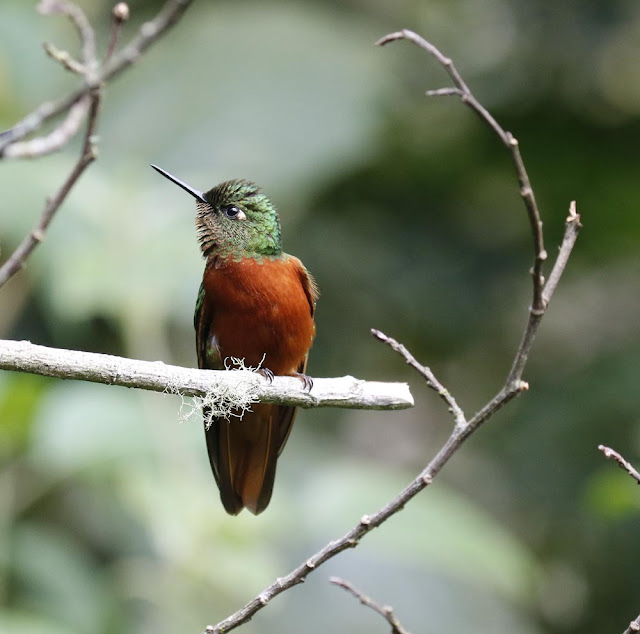Enough of the fog, snow and rain in this benighted country I say and enough of the corona virus too, that has so blighted our lives. Today I am taking a trip down memory lane to happier and sunnier times in Ecuador and Colombia, two South American countries that I visited in what now seems a lifetime ago but is in fact only a few years past.
Nothing epitomises South America more for me than hummingbirds. Often colloquially called 'hummers' there is no equivalent bird in Europe. They are usually very small, a flying miracle, possessing the speed, elusiveness and manoeuvrability of an insect. Indeed the nearest thing we have to them here is an insect, the Hummingbird Hawkmoth which is sometimes mistaken for the real thing!
Hummingbirds live their life at an incredible pace, constantly active, combative, fuelled on high octane nectar and sugar and are utterly captivating.The iridescence of their brilliant plumage flashes on and off like tiny beacons. There is never a dull moment either in their appearance or their actions.
Refreshingly, many species remain common and hummingbirds can be found virtually everywhere from cities to the remotest areas in mountains. Their spectacular colours make one feel they should be rare as every time you see one there is a sense of encountering something very special, but they are not rare and swarms of them visit artificial feeders that many people hang out for them to feed from.What a joy it must be to have them visiting your garden or verandah in a constant procession from dawn to dusk, their tiny bodies milling around the feeders like moths around a light.
Many have exotic and wonderful names such as Black throated Mango, Blossomcrown, Green throated Mountaingem, Santa Marta Woodstar and Rainbow bearded Thornbill to name but a few.
There is nothing more pleasurable than to sit on a hotel verandah with a cold drink and while away an hour or more as countless numbers of them come to feed on the specialised nectar holders placed in the nearby bushes and trees or hanging from the balcony. Everywhere, from the lowliest of accommodation to high end luxury hotels and lodges are onto hummingbirds and their unfailing attraction to visitors, both local or foreign such as myself.
Even the humblest of abodes with nothing more than a small garden, a couple of feeders and a few strategically placed chairs, can attract hummingbirds and bring a welcome source of supplemental income from passing visitors.
There are between 330 and 360 species of hummingbird in the world today, all confined to the Americas.They exhibit a great diversity of plumage, very often in brilliant iridescent colours that seem to alternately glow and then fade as the bird unwittingly moves and catches the light at certain angles. They can be found from humid, hot climes at sea level then ranging through a variety of habitat and elevation to an altitude of almost five thousand metres where temperatures can drop to well below freezing. Many have adapted to co-evolve with certain plant species on which they exclusively depend for nectar. Most will also prey on small insects to supplement their diet.
Nothing can compare to the experience of a couple of hours around noon when it is too hot to go birding, sitting in the shade by the hummingbird feeders and having them come so close that you can hear the faint hum from wings moving so fast they are but a blur. Often they come so close that the disturbed air caresses your face before they disappear at high speed in a flight that can only be described as erratic and eccentric.
Here are a few of the hummingbirds that I have seen on my travels to South America and that have given me such pleasure.
Green bearded Helmetcrest-male
 |
Paramo de Sumapaz National Natural Park, nr Bogota, Colombia, February 2016 |
I photographed this superb hummingbird at an elevation of 4300 metres above sea level at the Sumapaz Paramo National Park in the Cundiboyacense Mountain Range which lie in the eastern Andes of Colombia It was early morning with a bitterly cold wind, the temperature only just above freezing and this male was frequenting a sheltered spot perching on a very strange plant called a Fraijelone, which is the height of a man and found only in the paramo. They are scarce birds and hard to find but this male had a favourite perch it always wanted to return to and by standing not too far away we managed to get close to it when it returned to the favoured perch. An absolute stunner and on seeing it I realised a lifetime's ambition. They not only feed on nectar but also will walk around on the ground seeking invertebrates. They are one of four helmetcrest species in their own genus Oxypogon, all being robust and short billed and only found at high altitudes.
Green Thorntail-male
 |
Mashpi, Ecuador, October 2014
This is a tiny hummingbird that shows a preference to inhabit the forest canopy althoug it can be seen lower on occasions. The plumage is mainly a shimmering green all over with a white band across the rump. It is comparatively uncommon and found in humid lowland forest such as on the foothills of the Andes. They feed on nectar from various plants although this one was doing very nicely from an artificial feeder. They derive their name from the fact the wire thin central tail feathers extend,in the case of the male, well beyond the rest of the tail.
|
Violet tailed Sylph-male |
Violet tailed Sylph-female
|
Las Tangaras Bird Reserve, Colombia, January 2016
I saw this spectacular and beautiful hummingbird in the lowlands of the western Andes in both Colombia and Ecuador where it is fairly common on the edges and interior of humid forests. It feeds fairly low down and when the light catches the feathers of its long forked tail they turn it a spectacular violet purple while the rest of its upperpart plumage adopts a blue and green iridescence, turning the bird to a creature of great beauty. Sylph is an appropriate name as a sylph is a mythological air spirit. When the bird is in flight the long outer tail feathers float in the air currents like paper streamers. The female although less spectacular and lacking the long tail is still exceptionally colourful when compared to many other species of female hummingbird. Females can be told from the closely similar female Long tailed Sylph by their blue crown which is green on a Long tailed Sylph.
|
Sword billed Hummingbird-male |
|
Sword billed Hummingbird-female
 |
Colibri del Sol Bird Reserve, Colombia, January 2016
When I first saw this extraordinary bird in Colombia I could but stare in amazement. Colleagues had told me of its amazing bill but nothing can really prepare you for the first sight of the real thing. Proportionate to its size it possesses the longest bill of any bird species in the world. The bird is around 13cms and its bill is almost as long again. When it perches it has to hold its bill up at an angle pointing skywards to counterbalance the weight of its body and you can always pick it out at feeders as it seems to be hovering so far back from all the other hummingbirds feeding at the same time. It is a large hummingbird and relatively uncommon, frequenting the forest edge and even gardens, its long bill enabling it to reach nectar deep in the corollas of flowers denied to other shorter billed hummingbirds. Unremarkable in plumage its bill makes it truly wonderful. Unable to preen with its bill due to its great length it uses its feet instead. It is so unique it is assigned its own genus.
|
White bellied Woodstar-male Male and female White bellied Woodstars
 |
Colibri del Sol Bird Reserve, Colombia January 2016
The four woodstars in the genus Calliphlox are some of the smallest hummingbirds in the world. The White bellied Woodstar is one of the larger ones but is still less than 3.5inches in size! In flight they appear to float in the air as if by magic, as their wings move so fast they are to all extents invisible. Their diminutive size means they are alway obliged to defer to the other hummingbirds coming to the feeders. Flying backwards, forwards and sideways with infinite grace, they are nevertheless persistent, hovering like giant bumblebees in seemingly effortless suspension, patiently waiting their turn at the feeders. Their wings although moving so fast in flight as to be virtually invisible make one of the loudest buzzing sounds of any hummingbird species which only enhances the comparison with a bumble bee. Utterly and totally enchanting and a great favourite of mine
|
Booted Racketail-male
 |
Las Tangaras Bird Reserve, Colombia, January 2016
This hummingbird acquires its name from two obvious characteristics, the large ruff of white feathering around its legs hence 'booted' and the long thin tail feathers with oval appendages at their tip hence 'racketail'. The white feathering around the legs is the most extensive of any 'booted' hummingbird. The overall plumage is metallic green and the tail feathers are longer than its body. Although quite small they are feisty and hold their own at the feeders which is where I photographed this male. The wings of some species of hummingbird are, on occasion held open as in this image, in a threatening gesture towards other species of hummingbird. |
Golden breasted Puffleg-sexes similar
 |
Hotel Termales del Ruiz, Manizales,Colombia January 2016
Another hummingbird with the curious white feathering around its legs but in this instance termed puffleg. They inhabit high elevation forest edges between 3000-3500 metres. I saw this uncommon, lovely hummingbird in a hotel garden not far below the still active Nevado del Ruiz volcano. In fact the volcano heated the hotel's outdoor and indoor swimming pools! When I first saw this 'hummer' it appeared an overall dull green but as it turned the light caught its plumage and turned it into another avian jewel. |
Buffy Helmetcrest-male
 |
Los Nevados National Park, Caldas, Colombia, January 2016
Another hummingbird I really wanted to see and found, like its cousin the Green bearded Helmetcrest, at a very high altitude, 3800 metres above sea level, very near to the Nevado del Ruiz active volcano. This individual was found feeding at the entrance to the park to which we were not allowed in due to the volcano spewing out poisonous fumes. I was initially searching at head height for this hummingbird but we found it virtually at our feet taking nectar from low flowers and also hopping on the ground after insects. It has a purple bib that you can just see in the top image. Sadly it was impossible to get a photo of it perched on top of a flower as the wind was too stong and it remained at or just above ground level, often clinging to the flowers as it fed. I cannot complain as sometimes they can be very elusive. I love the ornate metallic green sheen on its upperparts
|
Lesser Violetear-sexes similar
 |
El Dorado Nature Reserve, Minca, Colombia, January 2016
Another hummingbird that appears superficially dark, being grass green but when it catches the light the green feathers take on a turquoise hue and the violet blue ear coverts are seen to their greatest effect. The bright ear coverts can be raised in display or aggressive encounters. It is one of the commonest hummers being found in humid habitats. Formerly it was lumped with another sub species but has recently been split so there are now two species, Mexican Violetear and Lesser Violetear which is found in Ecuador and Colombia |
Crowned Woodnymph-male
 |
El Dorado Nature Reserve, Minca, Colombia, January 2016
There is not much one can add by way of superlatives to this thankfully common, medium sized hummingbird. It can appear all dark especially when seen in the shade of evergreen forest in tropical lowlands up to 2500 metres, but in the sunlight it transforms into a bird of brilliant shining emerald green and violet plumage. After spending much time at the feeders at El Dorado Lodge I finally captured this image of one as it briefly caught the sunlight and became afire with green and purple iridescence. |
Brown Violetear-sexes similar
 |
El Dorado Nature Reserve, Minca, Colombia, January 2016
Not all hunmmers have bright colouring and here is one to prove the point, drab brown with the only colour being on the throat and side of the neck. This is a large uncommon hummingbird, related to the Lesser Violetear and markedly aggressive, spending more time chasing off other hummingbirds than feeding. It inhabits middle elevations of sub tropical and tropical habitat up to 1600 metres when breeding but moves as low as 400 metres outside the breeding season. In parts its range overlaps with that of the Lesser Violetear. Understated and superficially dull, its aggressive nature makes it noticeable. For me it was still attractive and a pleasure to see, especially as it is relatively uncommon |
Rufous tailed Hummingbird-male |
Minca Hotel, Minca, Colombia, January 2016
The two images above illustrate just how the light can transform a hummingbird from a bird of relatively subdued colour to one that positively dazzles as its body changes position. The rufous tail is extensive and frankly makes its identity uunmistakeable. It is a common, one could say abundant hummingbird up to an elevation of 1850 metres and it can often be found at relatively low levels in gardens and at forest edges.It tends to dominate other hummingbirds with its aggressive demeanour and will vigorously defend flowers and shrubs which it considers its territory. |
Buffy Hummingbird-sexes similar
 |
Los Flamencos National Reserve, San Pedro de Atacama, Colombia, January 2016
A dull, uniformly buff coloured hummingbird with olive tinged upperparts and cinnamon underparts that inhabits dry forest, open areas and scrubland where it often finds itself not in competition with other hummingbirds. It subsists mainly on the nectar, flesh and juice of cactus plants, shrub flowers and other desert plants. It is decreasing in population but is not threatened yet and is still considered to be locally common. Despite its unspectacular appearance I still found it attractive on what was a very hot day near the Caribbean coast.
Golden bellied Starfrontlet-male
Chicaque National Park, Bogota, Colombia, January 2016
This was one of the first hummingbirds I saw on my first ever day in Colombia and what a spectacular one to see. It was feeding with numerous other hummingbirds just outside the restuarant where we were to have lunch and I was so captivated by its beauty I sacrificed lunch in order to get this photo.In my opinion it remains one of the most spectacularly beautiful hummingbirds I have seen on my three visits to South America. It certainly got me hooked on hummingbirds and was a great introduction to Colombia and its birds |
Great Sapphirewing-male
 |
Tambo Condor, Penon del Isco, Ecuador, November 2018
One of the largest hummers and in my experience one of the most aggressive around. Scattering all the other hummingbirds as it arrives at the feeders, often landing and holding its wings out for a few seconds just to assert its dominance.The wings are all blue and the body plumage appears dark green until the light transforms it to the most exquisite metallic turquoise.
|
Giant Hummingbird-female
 |
Tambo Condor, Penon del Isco, Ecuador, November 2018
A veritable monster this is the largest of all hummingbirds being roughly the size of a European Starling but a lot lighter in weight. There is little or no iridescence in its drab plumage which is grey brown suffused with olive tones on the upperparts apart from an irregular whitish area on its rump, whilst the underparts are rusty brown, but somehow its sheer size and chutzpah give it an irresistable charm and character all its very own, despite its unremarkable appearance. It favours open dry habitats in woodland and scrub from 2000-4300 metres above sea level. They are the only member of the genus Patagona. I watched this one whilst an Andean Condor was cruising above!. |
Sparkling Violetear-male
 |
Tambo Condor, Penon del Isco, Ecuador, November 2018
This individual was coming to perch near to the feeders in the early morning but it took an age until the sun had risen sufficiently and was in the right position to illuminate its plumage turning each feather into a turquoise scale, highlighting each feather like chain mail or scales. A vivid patch of purple on its belly only served to enhance its beauty. Almost my top favourite hummingbird but not quite competing with the helmetcrests. Like the Lesser Violetear it can raise and lower its violet ear coverts in display |
 |
Las Tangaras Reserve, Colombia, January 2016
This is another impressive hummingbird and quite large as hummingbirds go, an impression enhanced by the male's long tail and bill. When caught at the right angle its plumage transforms from a basic dark green into a variety of colours from emerald green, citrus yellow, purple and blue. Unlike many female hummingbirds the female is quite colourful in her own right. They lead a solitary existence, usually inside the forest edge and are not uncommon, being found in sub tropical and tropical lowland and montane forest usually above 900 metres in northwest Ecuador and western Colombia. It was named after Empress Eugenie. |
Velvet Purple Coronet
 |
Mashpi, Ecuador, October 2014
A hummingbird that appears black and white until its plumage flashes the most glorious and wonderful hues of metallic turquoise and purple as it moves position and the feathers reflect the sun for an instant. It is almost as if a light comes on only to be extinguished in seconds as the bird moves once more and the plumage reverts back to a more mundane appearance. Forever restless. even by hummingbird standards, they too can be quite aggressive towards other hummers and even larger birds such as tanagers. |
Tourmaline Sunangel-male
 |
Guango Lodge, Papallacta, Ecuador, November 2018
A dark looking hummingbird that reveals a brilliant purple pink throat and greenish blue sheen to its body when caught at the right angle. The most frequently encountered of the various sunangels and happy to inhabit waste ground and gardens from 2300-3400 metres
Long tailed Sylph-male
|
 |
Colibri del Sol Reserve, Colombia, January 2016
Similar in size and form to the Violet tailed Sylph it lacks the metallic purple tail and can look quite dull until it turns to face you and its forehead and crown become electric blue and its throat purple. It generally inhabits higher elevations than the rather similar Violet tailed Sylph, although the altitudinal ranges can overlap, discretely perching in the shade of the forest edge between bouts of feeding. |
Violet fronted Brilliant-male
 |
near Baeza, Ecuador, November 2018
We stopped at an inconsequential little hut by the road where you left $2.50 in a tin to watch hummingbirds coming to some feeders. This understated but rather nice litle chap was endeavouring to come to the feeders but was forever chivvied away by the bigger and more aggressive Sparkling Violetears. Eventually it managed to get to the feeders while the violetears were squabbling amongst themselves. I also recall we saw it in torrential rain, not an uncommon occurence in South America.
Chestnut breasted Coronet-male
Guango Lodge,\Papallacta, Ecuador November 2018
Of all the hummingbirds I have seen in Ecuador and Colombia this species was by far the most pugnacious.Forever confrontational, they never ceased bickering with both their fellows and all the other species of hummingbirds visiting the feeders. Their constant and frenzied activity provided a ceaseless entertainment as they chased off rivals before returning to perch for a few seconds before yet again flying off to confront another interloper. After a while it became a bit frustrating as other species of hummingbird that I wanted to see were given the treatment by this most aggressive of hummingbirds |
Black tailed Trainbearer-male

 |
Tambo Condor, Penon del Isco, Ecuador November 2018
While I was watching the sapphirewing I noticed this small hummingbird with an enormously long black tail perched on top of a tall flower. They inhabit dry scrubby areas and degraded forest at elevations of 2300-3400 metres. Unlike many other hummingbirds they do not visit feeders that often, preferring to feed from wild flowers.Their plumage is emerald green but it is the very long tail that catches the eye streaming out from behind the bird as it flies.
Speckled Hummingbird-sexes similar
San Isidro Lodge, Ecuador, November 2018
A small hummingbird with comparatively subdued plumage, showing just some emerald green iridescence on its upperparts. Not the most spectacular of its kind but nevertheless posesses a singular charm.I watched this one being bullied by the larger Chestnut breasted Coronets but it refused to be cowed and eventually got its turn at the feeders. This one was resting on a large palm leaf during a morning of torrential rain
|





















































Gorgeous - magical creatures - wanna see some more, one day.... x
ReplyDelete